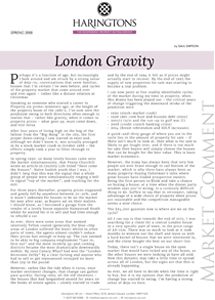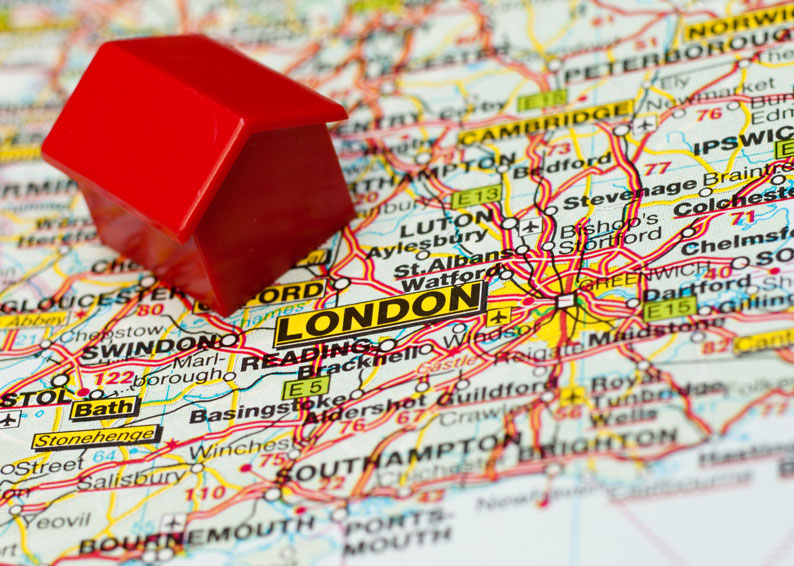
Perhaps it’s a function of age, but increasingly I look around and am struck by a strong sense of deja-vu; conversations that seem familiar, houses that I’m certain I’ve seen before, and cycles of the property market that come around over and over again – rather like a distant relation at Christmas.
Speaking as someone who started a career in Property six prime-ministers ago, at the height of the property boom of the 1980’s, I’ve now seen the pendulum swing in both directions often enough to realize that – rather like gravity, when it comes to property prices – what goes up, must come down, and vice versa.
After four years of living high on the hog of the fallout from the “Big-Bang” in the city, the first proper down-swing I saw started in in 1990 and, although we didn’t know it, was actually presaged in by a stock market crash in October 1988 – the effects simply took a year to filter through to property.
In spring 1990, so many lovely houses came onto the market simultaneously, that Penny Churchill wrote an article in Country Life titled “Here come the Houses”. Naïve foolish youth that I was, I didn’t twig that this was the signal that a whole group of people were simultaneously ringing a bell to signal “top of the market”, and reaching for the exit.
For three years thereafter, property prices stagnated and gently fell by anywhere between 20-30%, and it wasn’t unknown for houses to be on the market for year after year, as buyers sat on their wallets. I should know, as I borrowed a garage from the vendor of a lovely house opposite Hampstead Heath whilst he waited for it to sell and had time enough to rebuild a car.
As ever, there were some areas that seemed relatively Teflon coated (generally the blue-chip areas of London suffered the least) whilst in other parts of town, the agents almost couldn’t reduce their prices fast enough to keep up. The rule seemed to be akin to big company employment “Last in, first out” and the most recently up-and-coming districts became the most dramatically downwardly mobile. By 1992 Canary wharf had won the “London Recession Derby” by a clear furlong and anyone who had to sell or got repossessed recouped no more than 50p in the pound.
However, rather like the tide when it turns, sentiment changes almost imperceptibly, but will inevitably gather pace quickly. During 1993, all the old chestnuts – the houses that had languished for years on the books of estate agents – all slowly started to trade and by the end of 1994 it felt as if prices might actually rise again; by the end of 1995 supply of new properties for sale was starting to become a real problem.
During my time in property, I can now point at five readily identifiable cycles of the market, where this drama has been played out – the critical years of change triggering the downward stroke of the pendulum have been
– 1990 (stock-market crash)
– 1998 (dot-com bust and Russian debt crisis)
– 2001/2 (9/11 and the run-up to gulf war II)
– 2008 (credit crunch banking crisis)
– 2014 (Brexit referendum and SDLT increases).
A quick-and-dirty gauge of where you are in the cycle lies in the amount of property for sale – if there isn’t much to look at, then what is for sale is likely to get fought over, and if there is too much for sale then buyers will simply choose the houses that can be bought for the best value. This is basic market economics.
However, the irony has always been that very few people are ever brave enough to call bottom of the market, which is why there have always been so many property-buying fisherman’s tales where great houses have eluded prospective owners. Being the first person to blink and take a chance on buying a house, at a time when the dinner party wisdom says you’re wrong, is a curiously difficult thing to do. Suffice to say that in retrospect, taking advantage of a wide choice of property when prices are reasonable and the competition manageable seems a wise choice.
The $64,000 question now is where are we on the cycle?
All I can say is that towards the end of 2015, I was searching for a client for a central London house in a very specific part of town, in the price range of £8-15m. There was so much to look at it took months to winnow out the chaff and leave us with a hard kernel of houses that we were interested in, and the client bought the best on our short-list.
Today, there isn’t a single house on the open market that would have ticked any of the boxes, as the other houses we were looking at have all sold. Now this dynamic may take a little time to spread across all of London, but the signs are that this is already happening.
As ever, we all have to decide when the time is right to buy, but it is my opinion that the pendulum of change has started to swing; I’m having a strong sense of deja-vu here.
Saul Empson, Director
